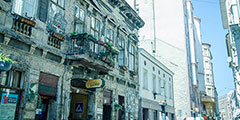Ruin pub, open-air cinema and farmers’ market at the same place
As its founders put it, Szimpla-ness is an experiment to find out whether it is possible to finance a group culture on a market basis in Budapest (and now in Vác and Berlin as well). Is it possible to survive yet another (re)construction project in the neighbourhood. To sell food based on a balanced diet. To autonomously distribute films in your own open air cinema. To organise animation film festivals on a community basis. The answer so far is yes. With its unposh style and openness to group cultures, with its owners being university students rather than the affluent young entrepreneurs associated in public consciousness with the world of cafés, who opened Szimplakert in 2002, the place has paved the way to a whole new school of entertainment and catering – now there are 25 similar places in its neighbourhood.
Szimplakert is a postmodern cultural centre with almost a million visitors each year, organising film festivals, exhibitions, theatre performances, a farmers’ market, a cyclists’ flea market, supporting talents – all this on 1400 square meters. Pensioners enter for half price. Journalist Márton Bede described Kazinczy Street as one of the most cosmopolitan neighbourhoods in Budapest. It crosses merely four streets, yet its stretches are unique and widely different from one another. Its section between Dob Street and Wesselényi Street is the only place in Budapest that gives you the feeling which makes the medieval inner cities of Mediterranean towns so exciting – you never know what comes after the corner. The next section speaks mostly about Jewish history – with an Orthodox synagogue, Restaurant Carmel and even a kosher pizzeria.
“He who wants to be free respects the freedom of the other”
– F. Kazinczy
Questions: What’s your favourite community space? Why?
How do you think this location is connected to the topic of peace?
What does this aspect of peace mean to you?
Recreation spots: Szimplakert itself, and the countless bars and entertainment spots in the neighbourhood. This is the only entertainment district in Budapest that was created as a result of private initiative.







 5 minutes
5 minutes






